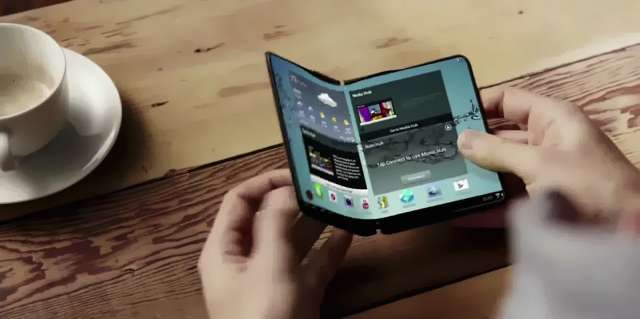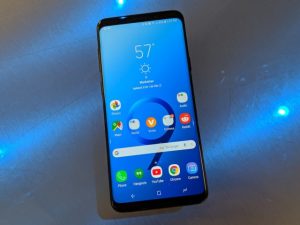We’ve pulled together a list based on patents and hearsay.

null (Samsung)
For years, we’ve heard rumors about a Samsung foldable smartphone called the Galaxy X.
The phone still hasn’t surfaced, but Samsung’s recent reporting of its 2017 financials got people wondering whether it’ll finally happen this year. Here’s one quote from that report, emphasis ours:
“For the Display Panel business in 2018, the company expects OLED to become a mainstream panel in the smartphone industry and will reinforce its competencies in new applications such as foldable, automotive, and IT displays.”
Here’s what we know about the rumored Galaxy X smartphone:
Fionna Agomuoh contributed to an earlier version of this story.
The Galaxy X could have more screen real estate compared to traditional smartphones, serving as more of a tablet at times.

The Samsung ultrawide monitor with many windows open. (Korean Patent Office)
Samsung’s patents and prototypes show a device that either opens and closes from side to side like a book, or horizontally like a notepad.
Either way, the fold will likely make it possible to incorporate bigger display options — most concepts suggest it would be comparable in size to a tablet when open.
It might also give users the option to split the screen into two panels that show different things or show one big picture, similar to what Samsung accomplished with its 48-inch ultrawide computer monitor.
The Galaxy X screen might need to protect itself, as a folded phone has its own set of vulnerabilities.

Cracked iPhone screen (Jeff Turner/Flickr (CC))
Depending on the material of the outside layer, a smartphone that folds on itself could serve as its own screen protector, but the fold might create new issues in terms of durability, as indicated by president of mobile communications business DongJin Koh.
“We want to have a good reaction from customers once the phone is out in the market. But there are still durability issues that we need to address,” he told reporters at a press briefing at CES in January.
It’s possible that pushing two screens against each other makes for a harsher impact on collision.
The Galaxy X could be bulkier than most modern smartphones

The ZTE Axon M. (Antonio Villas-Boas/Business Insider)
Most smartphone manufacturers have spent years making devices slimmer, and a foldable smartphone could be like adding a layer to a thin phone or stacking two thin phones on top of each other.
The ZTE Axon M, marketed as the first foldable smartphone, is made of two displays attached by a mechanical hinge — but it’s almost 1.5x thicker than Samsung’s Galaxy S9.
And if the size of the display is comparable to a tablet’s, then we can assume the device will be closer in weight to a tablet, too.
It will most likely be expensive.

The price of the Samsung Galaxy S8. (Samsung)
It’s unclear what Samsung’s foldable phone might cost, but for reference, Samsung’s most expensive phone, the Galaxy Note 8, costs about $950 (Unlocked).
Plus, new display technologies tend to make smartphones more expensive: In the past few years, consumers have seen Samsung’s curved display smartphones steadily increase in price, and the starting price of the newest iPhone has gone from $640 to $1,000, partly because Apple switched from an LCD to an OLED display.
Other factors could affect Galaxy X’s price, like memory, storage capacity, and external materials.
A Galaxy X phone would have a host of issues we can’t predict.

A Samsung Galaxy S8 with the company’s artificially intelligent assistant, Bixby, on the home screen. (Hollis Johnson)
New technologies almost always have issues that don’t come up until the product is on the market, at which point millions of consumers use it and voice their opinions about things that might have been overlooked in testing (consider every tech-related __-Gate in recent history).
There could be a lot of issues with the phone’s main feature, its foldable display, but the unique layout will probably also influence a lot of other aspects of the phone, like battery life, memory, and aesthetics, to name a few.
Samsung’s edge panel could become obsolete with a foldable Galaxy X.

The Samsung Galaxy Note Edge. (Business Insider)
Samsung will probably lose the signature curved-edge display on the Galaxy X, so that it can properly close on itself.
Since the edge display is where shortcuts and quick functions are housed, it might not even be necessary on a screen with more real estate. Plus, as it is right now, the edge display can’t be used simultaneously with the main screen; multitasking would be better on a foldable phone.
Expect extremely limited availability to start.

A Samsung Galaxy Round. (Samsung)
Limited availability is a tactic that has worked for Samsung in the past: In 2013, Samsung released the Galaxy Round — its first attempt at a smartphone with a curved display — to select Asian markets so it could learn from its mistakes to wow a larger population.
The following year it released the Galaxy Note Edge, which had a single curved edge and it wound up serving as the blueprint for every curved-display device on the market.
It’s not a bad play, considering the amount of scrutiny the foldable phone will face, but it does mean that our chances of seeing it sooner rather than later are slim.
ATTENTION! ATTENTION!! ATTENTION!!! ADVERTISE ON TOKTOK9JA AND REACH OUT TO YOUR DESIRED AUDIENCE: HERE
Discover more from TOKTOK9JA MEDIA
Subscribe to get the latest posts sent to your email.






























